Characterization of topological phase of superlattices in superconducting circuits
2022-08-31JianfeiChen陈健菲ChaohuaWu吴超华JingtaoFan樊景涛andGangChen陈刚
Jianfei Chen(陈健菲) Chaohua Wu(吴超华) Jingtao Fan(樊景涛) and Gang Chen(陈刚)
1State Key Laboratory of Quantum Optics and Quantum Optics Devices,Institute of Laser Spectroscopy,Shanxi University,Taiyuan 030006,China 2Collaborative Innovation Center of Extreme Optics,Shanxi University,Taiyuan 030006,China
3Collaborative Innovation Center of Light Manipulations and Applications,Shandong Normal University,Jinan 250358,China
Keywords: superconducting circuits,topological phase transition,edge state,interface state
1. Introduction
As one of the leading quantum platforms for implementing scalable quantum computation,[1–3]superconducting circuits have achieved great experimental progress in the past few years. In particular, due to the site-specific control and readout techniques,as well as the flexible and engineerable system designs,[4–6]a superconducting circuit system has emerged as a rich platform for quantum simulation.[7–10]By performing analog quantum simulations, a wide range of many-body physics has been employed in such simulators, such as the Bose–Hubbard model,[11–13]many-body localization,[14–18]quantum walks,[19–21]and dynamical phase transitions.[22]Moreover,due to the flexibility and diversity of superconducting quantum circuits system, it is also an excellent platform to realize exotic topological phases of matter and to probe and explore topologically protected effects,including the detection of topological invariant,[23]topological state transfer,[24,25]and higher-order topological phases.[26,27]
In a recent experiment,[28]topological magnon insulator states have been observed in a one-dimensional (1D) superconducting qubit chain with a tunable dimerized spin chain,which is analogue to the Su–Schrieffer–Heeger (SSH) model with two bands. Actually,various extended SSH models have been proposed to study novel topological physics by considering some other modulation terms, such as long range hoppings,[29]periodically driving,[30–32]and non-Hermitian modulation.[33–36]Recently, 1D superlattices with multiple sites(>2)in each unit cell have garnered much interest.[37–40]Such multiband systems show richer topological features than two-band models, such as the ability to tune the number of topological edge states by controlling the couplings,which allow one flexible control over the topological states in a new domain. Moreover,the superlattices with even sites in each unit cell preserve the chiral symmetry, and the topological phases can be characterized by the winding number.
In this work,we present an experimental feasible scheme to achieve the simulation of topological superlattice in a superconducting qubit chain with tunable coupling strengths. Such one-dimensional superlattices possess multiple topologically nontrivial dispersion bands and tunable edge states. Specifically,by considering a quadrimeric superlattice(SSH4model),we show that the topological invariant(winding number) can be effectively characterized by the dynamics of the singleexcitation quantum state through an extended mean chiral displacement. Moreover, we explore the appearance and detection of the topological protected edge states in our qubit system. Finally, we also demonstrate the Bloch-oscillation-like dynamics induced by the interference of topological interface states with different propagation constants.
This article is organized as follows. Section 2 gives the feasible method to achieve one-dimensional superlattice in superconducting circuits. Section 3 demonstrates the measurement of topological winding number for quadrimeric lattice.Section 4 explores the existence and detection of topological edge states. Section 5 shows the dynamics of interface state propagation.
2. Model and Hamiltonian
Based on the recent experiment,[28]we consider a onedimensional spin chain consisting ofNcapacitively coupled qubits as shown in Fig. 1(a). The Hamiltonian of the system can be expressed as
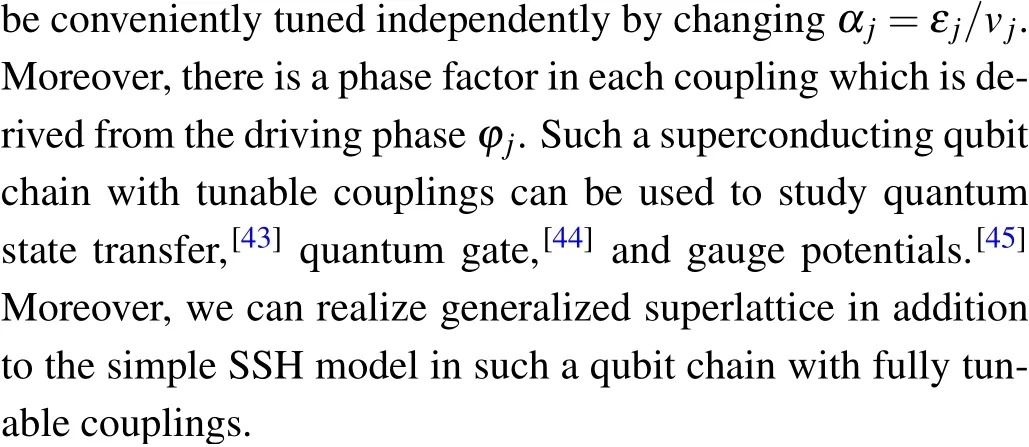
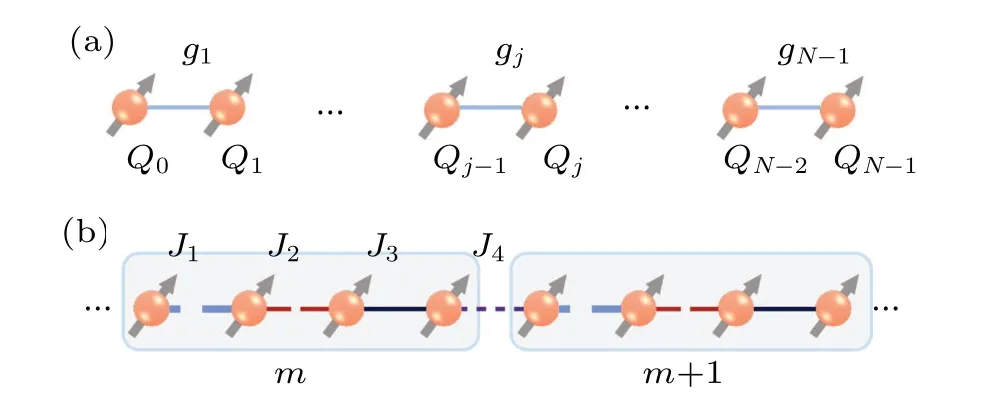
Fig. 1. (a) Schematic diagram of a qubit chain. Here, Qj denotes the jth qubit,g j is the coupling between neighboring qubits. (b)Schematic diagram of a quadrimeric superlattice with four qubits in each unit cell.J1, J2, and J3 are the intra-cell couplings, whereas J4 is the inter-cell coupling.
To demonstrate the topological properties of superlattice in superconducting circuits, here we focus on a superlattice qubit chain with four qubits in each unit cell denoted as{1,2,3,4},as shown in Fig.1(b),which is known as the SSH4model. For such a quadrimeric lattice,the Hamiltonian reads

wheremis the unit cell index,Mis the number of the unit cells,J1,J2,andJ3denote the intracell qubit coupling strengths andJ4is the intercell qubit coupling strength. For simplicity, we take ¯h=1 and setJ1as the energy scale.
Note that the Hamiltonian (9) describes an interacting spin chain. Here, we consider the single-excitation case, i.e.,one of the qubits is excited to the excited state|e〉and the others stay in the ground state|g〉.
3. Topological phase transition
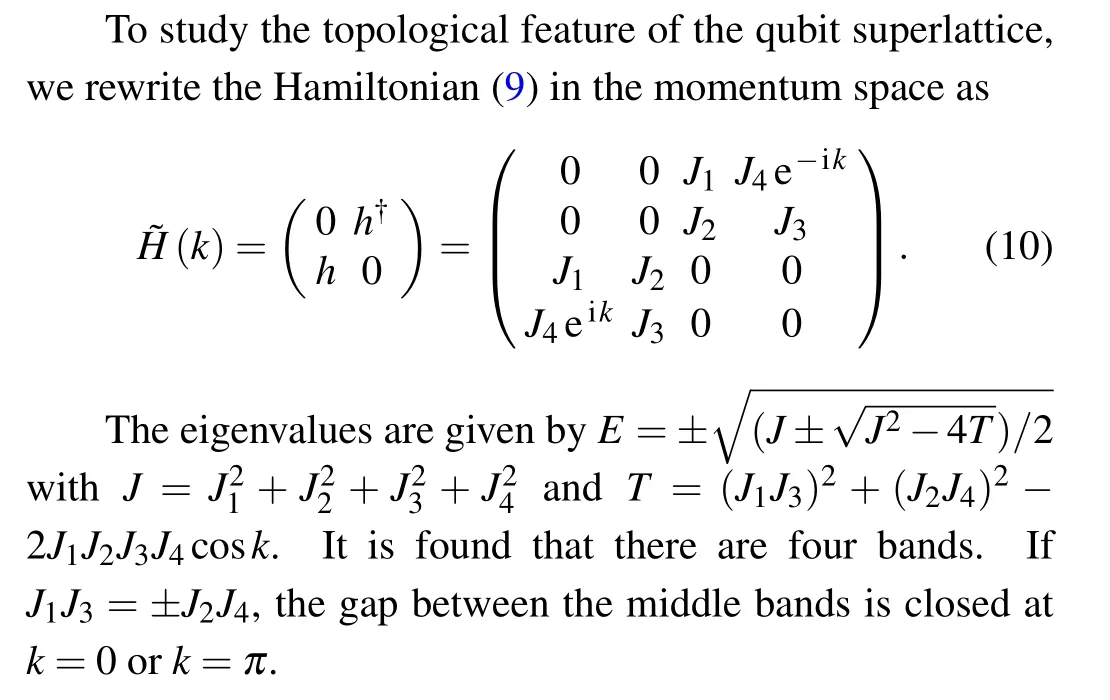
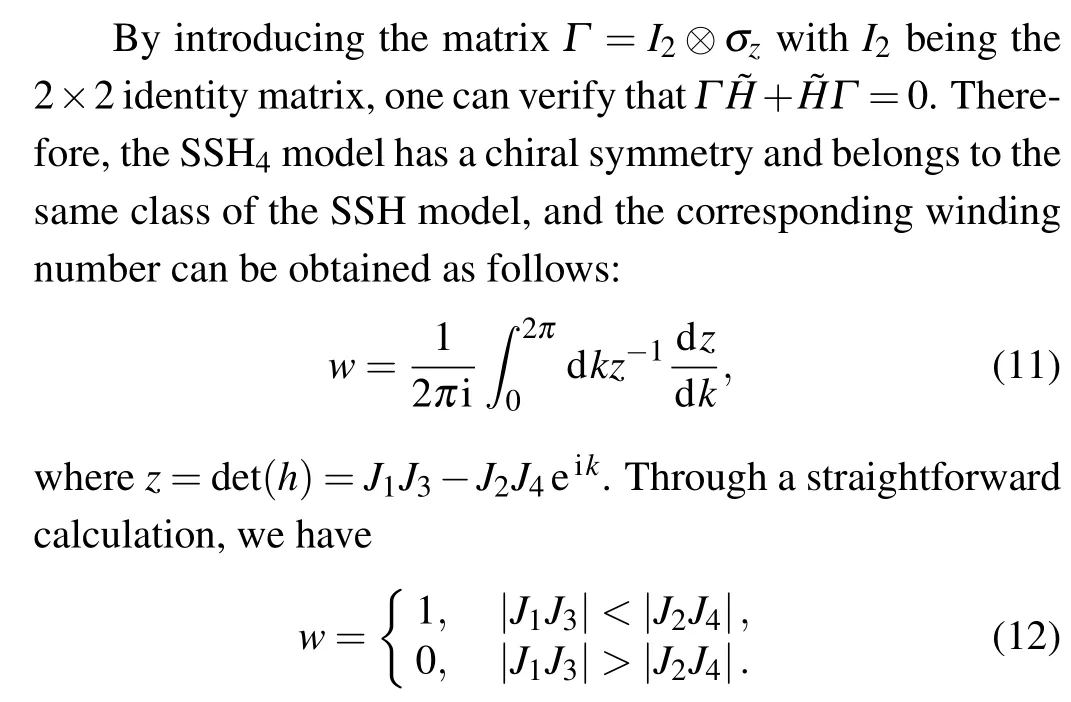
The winding numberw=1(0)shows that the above qubit chain[Eq.(9)]is in the topologically nontrivial(trivial)phase.
For one-dimensional chiral symmetric systems,the winding number is an important topological invariant used to characterize the topological phase and can be measured through the dynamics of quantum state. That is, the winding number can be extracted from a time-dependent quantity–mean chiral displacement (MCD), which has been measured experimentally in cold atoms,[46]photonic system,[47]and superconducting qubit chain for the SSH-type model.[28]For the SSH4-type qubit chain,we define the chiral displacement operator as(see the appendix)
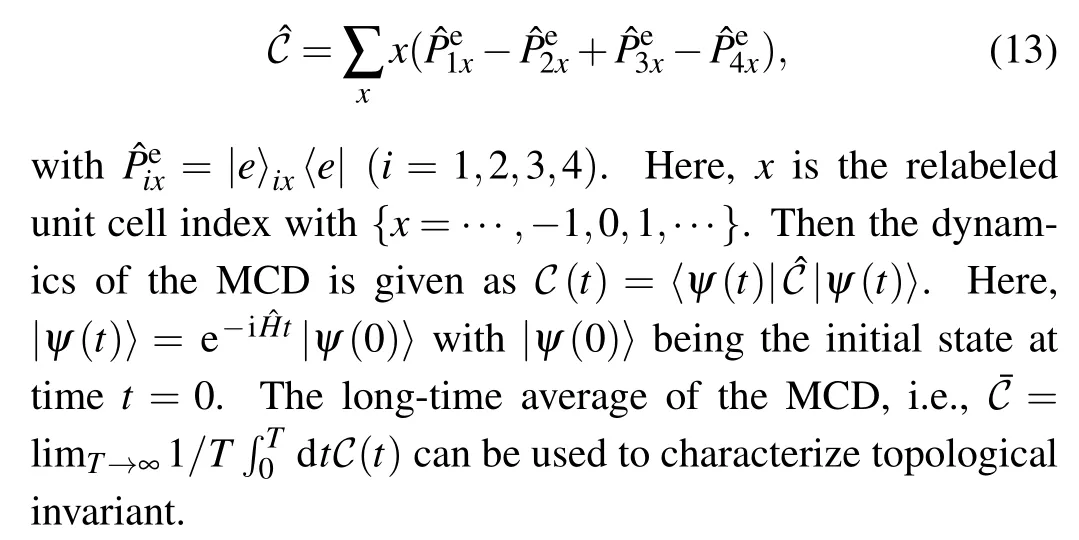
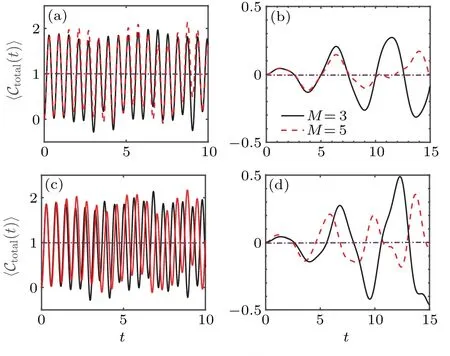
Fig.2.(a)and(b)The dynamics of Ctotal(t)with J4=5(a)and J4=0.2(b),respectively. (c)and(d)The dynamics of〈Ctotal(t)〉with J4=5(c)and J4=0.2(d),respectively.Here,〈···〉denotes the disorder-averaged Ctotal(t). The other parameters are chosen as J1=J2=J3 and W =0.2.
In order to detect the winding number for the SSH4-type qubit chain, we consider two single excitation initial states localized on the central unit cell,i.e.,|ψ1(0)〉=|gggg,...,eggg,...,gggg〉and|ψ3(0)〉=|gggg,...,ggeg,...,gggg〉. The corresponding MCDs are denoted asC1(t)andC3(t),respectively. The topological winding number can be extracted from the total MCD–Ctotal(t)=C1(t)+C3(t),that is,

As shown in Figs.2(a)and 2(b),we simulateCtotal(t)for different configurations withJ4>J1(=J2=J3)andJ4 To demonstrate the robustness of the MCD, we add the disorder to each qubit couplings asJmi=Ji+Wδ, whereWis the disorder strength andδ ∈[−0.5,0.5]is a random number. In Figs. 2(c) and 2(d), we show the disorder-averaged MCD〈Ctotal〉by averagingCtotal(t) over 30 independent disorder configurations for trivial and nontrivial phases. It can be seen that〈Ctotal〉is robust to the weak disorder, maintaining oscillation center around 1 and 0 forJ4>J1andJ4 In Figs. 3(a1)–3(a3), we plot the Zak phaseZn(n=1,2,3)of the corresponding band gap of the SSH4model under the inversion symmetry. We find thatZnis quantized and can take the values zero orπ,denoting the trivial and nontrivial topological phases,respectively. The nontrivial Zak phase implies that a pair of topologically protected edge states will appear at the boundaries of the system. In the case ofJ1̸=J3, the superlattice has no inversion symmetry. Figure 3(b) shows the energy spectrum and Figs. 3(b1)–3(b3) show the corresponding gap Zak phaseZnwithJ1̸=J3. It can be seen that the Zak phase of the middle gap is quantized, and a pair of degenerate zero-energy edge state emerge forJ4>J4,2(=J1J3/J2). However,for the upper and lower gaps,the Zak phasesZ1,3are not quantized and vary continuously. The non-degenerate edge states emerge without experiencing a gap closing and reopening point, and they are not topological. Fig.3. (a)The energy spectrum with the inversion symmetry{J1=J3=1,J2=1.2}. (a1)–(a3)The corresponding band gap Zak phases Zn versus the inter-cell coupling J4. (b)The energy spectrum without inversion symmetry{J1=1,J3=0.5,J2=0.5}. (b1)–(b3)The Zak phases corresponding to all band gaps. Fig.4. (a)The energy spectrum with J4=0.5(blue circle)and J4=2(red dot). (b1)–(b3)The distribution of wave functions of the three pairs edge states indicated by circles in(a), respectively. (c)and(d)The time evolution of the single-excited state population for J4 =0.5(a)and J4=2(b),respectively. The other parameters are chosen as J1=J3=1 and J2=1.2. The above discussion shows that the number of topological edge states can be controlled by tuning the inter-and intracell couplings. The topological edge states can be detected by the dynamics of the single-excitation quantum state. As an example, in Fig. 4(a), we plot the energy spectrum withJ4=0.5 (blue circle) andJ4=2 (red dot). In the topological phase (J4=2), there are three pairs of edge state in the gaps and the distribution wave functions of them are shown in Figs.4(b1)–4(b3). Figures 4(c)and 4(d)show the time evolution of the single-excited state (|ψ(0)〉=σ+1|G〉) population forJ4=0.5 andJ4=2,respectively. For the non-topological phase,the excited state spreads into the bulk over time,while in the topological phase with edge states,the wave-packet remains localized around the boundary unit cell. Another important topological aspect is the existence of interface states between two topological distinct insulators.As shown schematically in Fig. 5(a), a topological interface(shaded region) can be created by combining two SSH4-type qubit systems with different topological properties [e.g., in Fig.5(a), the qubit array on the right(left)represents a topologically nontrivial(trivial)array withJ4 Fig.5. (a)Schematic diagram of the two-coupled-qubit chain with different topological phases. The central shaded region denotes the interface. (b) The energy spectrum of the qubit configuration shown in(a). The red dots represent the interface states. (c) The distribution wave function of the interface states. The parameters are chosen are J1=J2=J3,J4=5 and M=10. To observe the dynamics of topological interface states,we excite the central qubit of the interface region [Fig. 5(a)].Such an initial state has a large overlap with the wave function of the interface states and it will propagate in the qubit chain via the interface states. Compared with the localized defect state in the SSH-type qubit chain, the interface states of superlattice exhibit exotic behaviors.[37,39]Figures 6(a)and 6(b)show the time evolutions of single-excitation state population withM=4 andM=2,respectively. It is found that the dynamics of the single-excitation exhibits Bloch-like oscillation. Such breathing-like oscillation is due to the interference of topological interface states with different propagation constants,which is quite different from general Bloch oscillation with a linear potential.[48]The results indeed indicate that the single-excited state is localized in the center interface region of the qubit chain, unambiguously demonstrate the existence of the topological interface states. Fig. 6. Time evolutions of all qubit’s excited state population with M =4 (a) and M =2 (b). The initial excitation is the central qubit of the interface region as shown in Fig.5(a). The other parameters are the same as those in Fig.5(b). In summary, we have constructed one-dimensional superlattices in superconducting circuits with tunable coupling strengths. As an example,we consider the quadrimeric lattice.Such a multiband system shows richer topological properties than the dimeric case. Through the non-equilibrium dynamics of a single-qubit excitation state,we show that the topological winding number can be measured by a dynamical dependent quantity, i.e., mean chiral displacement, which takes zero for the trivial phase and 1 for the nontrivial phase. Moreover,we have demonstrated the existence of topological edge state under different parameters region. Finally,the stable Bloch-like oscillation of multiple interface states induced by the interference of them has been demonstrated. In the experiment,accurate single-shot readout techniques enable us to synchronously record the dynamics of all qubits and to observe the evolution of a single-excitation state. In addition,the physics presented here persists even for finite size, indicating the feasibility of experimental measurements. Note that similar physics can be extended to superlattices with arbitrary number of qubits in each unit cell. Our work potentially paves the way for exploring novel topological states of matter in controllable superconducting circuits. Acknowledgements Project supported by the National Natural Science Foundation of China(Grant Nos.12034012, 12074232,12125406,and 11804204)and 1331KSC.4. Detecting of edge states




5. Dynamics of interface state

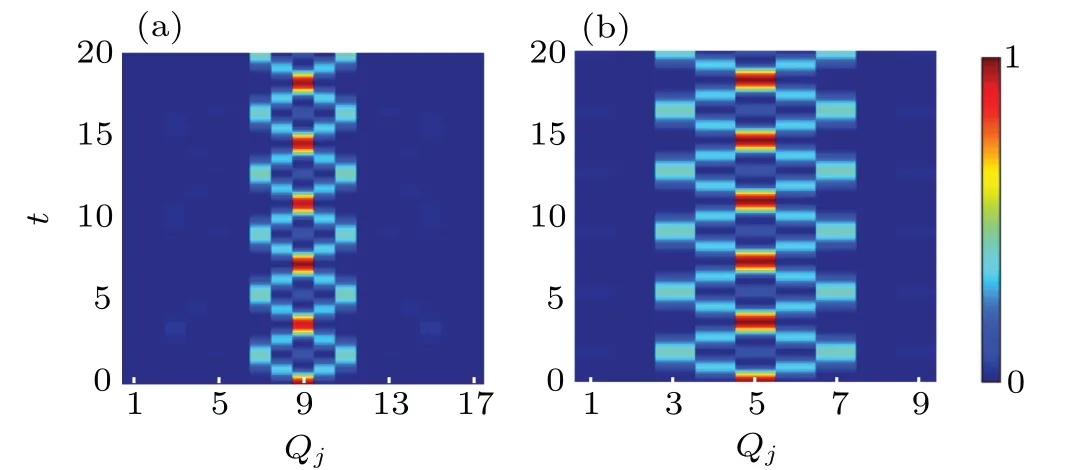
6. Conclusion

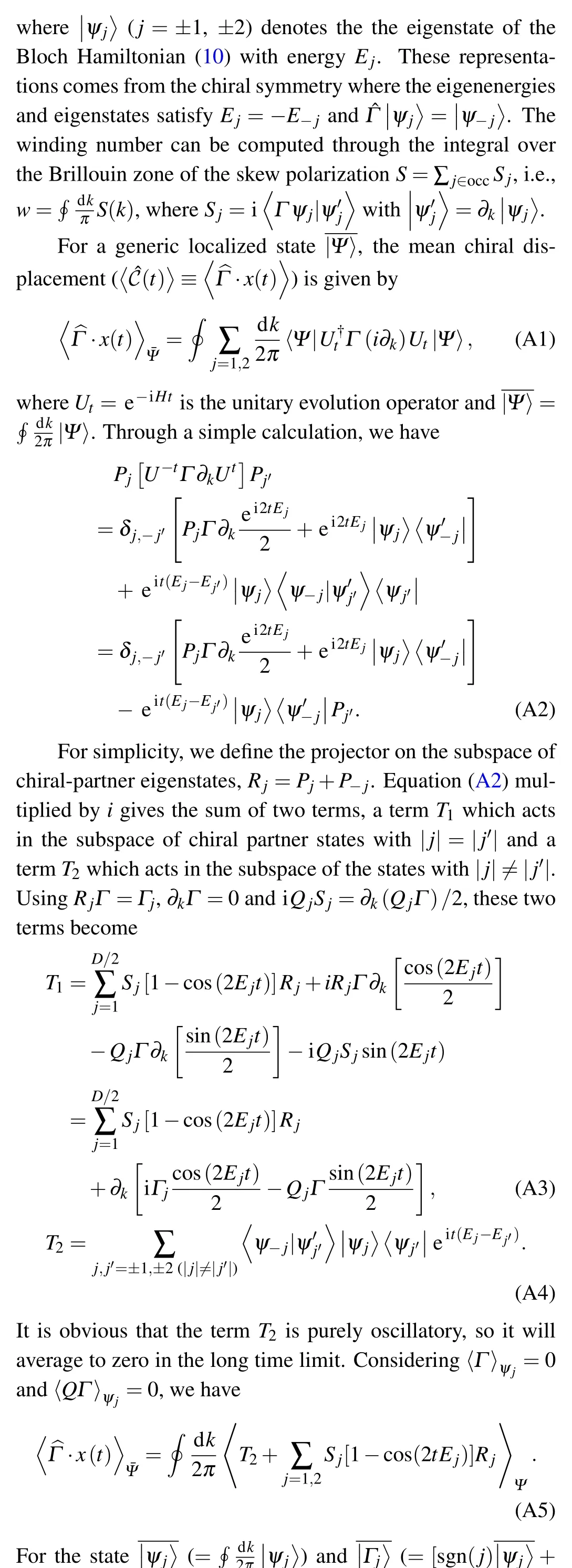
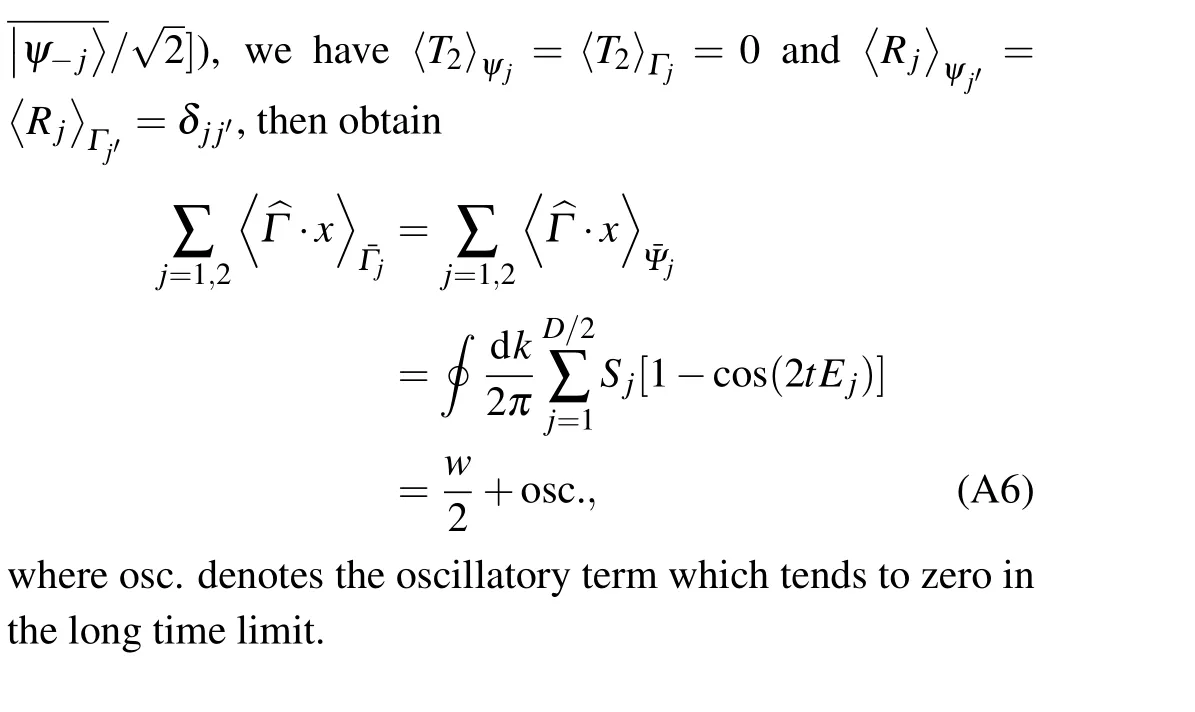
杂志排行
Chinese Physics B的其它文章
- Direct measurement of two-qubit phononic entangled states via optomechanical interactions
- Inertial focusing and rotating characteristics of elliptical and rectangular particle pairs in channel flow
- Achieving ultracold Bose–Fermi mixture of 87Rb and 40K with dual dark magnetic-optical-trap
- New experimental measurement of natSe(n,γ)cross section between 1 eV to 1 keV at the CSNS Back-n facility
- Oscillation properties of matter–wave bright solitons in harmonic potentials
- Synchronously scrambled diffuse image encryption method based on a new cosine chaotic map
